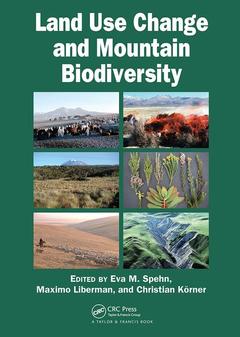Description
Land Use Change and Mountain Biodiversity
Coordinators: Spehn Eva M., Liberman Maximo, Korner Christian
Language: English
Keywords
Geometrid Moths; Quebrada De Humahuaca; alpine; Persistent Soil Seed Banks; global mountain biodiversity assessment; Rupicapra Rupicapra; land use change; High Elevation Grassland; rangeland vegetation; Moderate Grazing Intensity; treeline ecotone; Life Form Spectrum; Vascular Plants; Rumex Acetosella; Bale Mountains; Treeline Species; Ungrazed Treatments; Podocarpus Forest; Los Toldos; Floristic Species Richness; Subalpine Zone; Wood Pastures; NMDS Ordination; Andean Wetlands; Eastern Pamir; Live Biomass; Total Aerial Biomass; Mature Forest Species; Marsh Meadows; Intermediate Plots
Publication date: 12-2019
· 17.8x25.4 cm · Paperback
Publication date: 01-2006
362 p. · 17.8x25.4 cm · Hardback
Description
/li>Contents
/li>Readership
/li>Biography
/li>
Part of the worldwide biodiversity program DIVERSITAS, the Global Mountain Biodiversity Assessment (GMBA) assesses the biological richness of high-elevation biota. GMBA?s focus includes the uppermost forest regions or their substitute rangeland vegetation, the treeline ecotone, and the alpine and nival belts. Providing more than description, the GMBA explains the causes of biological richness and how diversity changes over time. Because biodiversity changes often result from human land use, part of the GMBA agenda is the assessment of land use impacts. These assessments are critical in low-latitude regions, where land use pressure on upland biota is the greatest.
The chapters of Land Use Change and Mountain Biodiversity derive from a peer-review process that followed presentations offered at two GMBA workshops, one in Tanzania and the other in Bolivia. More than 50 researchers actively participated in these events, discussing information from all major mountain regions, with a particular focus on the Andes and on African mountains.
High-Elevation Land Use, Biodiversity, and Ecosystem Functioning.
Diversity of Afroalpine Vegetation and Ecology of Treeline Species in the Bale Mountains, Ethiopia, and the Influence of Fire.Is Afroalpine Plant Biodiversity Negatively Affected by High-Altitude Fires?The Impact of Fire on Diversity, Structure, and Composition of the Vegetation on Mt. Kilimanjaro. Effects of Fire on the Diversity of Geometrid Moths on Mt. Kilimanjaro. The Influence of Fire on Mountain Sclerophyllous Forests and Their Small-Mammal
Communities in Madagascar.Fire, Plant Species Richness, and Aerial Biomass Distribution in Mountain Grasslands
of Northwest Argentina. The Biodiversity of the Columbian Páramo and Its Relation to Anthropogenic Impact. Grazing Impact on Vegetation Structure and Plant Species Richness in an Old-Field Succession of the Venezuelan Paramos. Vegetation and Grazing Patterns in Andean Environments: A Comparison of Pastoral Systems in Punas and Páramos. Grazing Intensity, Plant Diversity, and Rangeland Conditions in the Southeastern Andes of Peru (Palccoyo, Cusco). Importance of Carrying Capacity in Sustainable Management of Key High-Andean Puna Rangelands (Bofedales) in Ulla Ulla, Bolivia. Functional Diversity of Wetland Vegetation in the High-Andean
Páramo, Venezuela.Millennia of Grazing History in Eastern Ladakh, India, Reflected in Rangeland Vegetation. Alpine Grazing in the Snowy Mountains of Australia: Degradation and Stabilization
of the Ecosystem. Plant Species Diversity, Forest Structure, and Tree Regeneration in Subalpine Wood Pastures. Vegetation of the Pamir (Tajikistan): Land Use and Desertification Problems.Effects of Grazing on Biodiversity, Productivity, and Soil Erosion of Alpine Pastures
in Tajik Mountains. Patterns of Forest Recovery in Grazing Fields in the Subtropical Mountains of Northwest Argentina.Climatic and Anthropogenic Influences on the Dynamics of Prosopis ferox Forests in
These books may interest you

Alpine Biodiversity in Europe 210.99 €



